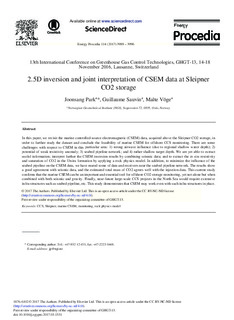| dc.contributor.author | Park, Joonsang | |
| dc.contributor.author | Sauvin, Guillaume | |
| dc.contributor.author | Vöge, Malte | |
| dc.date.accessioned | 2017-08-24T07:25:04Z | |
| dc.date.available | 2017-08-24T07:25:04Z | |
| dc.date.created | 2017-08-21T10:30:02Z | |
| dc.date.issued | 2017 | |
| dc.identifier.citation | Energy Procedia. 2017, 114 3989-3996. | |
| dc.identifier.issn | 1876-6102 | |
| dc.identifier.uri | http://hdl.handle.net/11250/2451675 | |
| dc.description.abstract | In this paper, we revisit the marine controlled-source electromagnetic (CSEM) data, acquired above the Sleipner CO2 storage, in order to further study the dataset and conclude the feasibility of marine CSEM for offshore CCS monitoring. There are some challenges with respect to CSEM in this particular area: 1) strong airwave influence (due to regional shallow water depth); 2) potential of weak resistivity anomaly; 3) seabed pipeline network; and 4) rather shallow target depth. We are yet able to extract useful information; interpret further the CSEM inversion results by combining seismic data; and to extract the in situ resistivity and saturation of CO2 in the Utsira formation by applying a rock physics model. In addition, to minimize the influence of the seabed pipeline on the CSEM data, we have muted some of data and receivers near the seabed pipeline network. The results show a good agreement with seismic data, and the estimated total mass of CO2 agrees well with the injection data. This current study confirms that the marine CSEM can be an important and essential tool for offshore CO2 storage monitoring, yet not alone but when combined with both seismic and gravity. Finally, near-future large-scale CCS projects in the North Sea would require extensive infra-structures such as seabed pipeline, etc. This study demonstrates that CSEM may work even with such infra-structures in place. | |
| dc.language.iso | eng | |
| dc.title | 2.5D Inversion and Joint Interpretation of CSEM Data at Sleipner CO2 Storage | |
| dc.type | Peer reviewed | |
| dc.type | Journal article | |
| dc.description.version | publishedVersion | |
| dc.source.pagenumber | 3989-3996 | |
| dc.source.volume | 114 | |
| dc.source.journal | Energy Procedia | |
| dc.identifier.doi | 10.1016/j.egypro.2017.03.1531 | |
| dc.identifier.cristin | 1487552 | |
| dc.relation.project | Norges forskningsråd: 193825 | |
| cristin.unitcode | 7452,4,5,0 | |
| cristin.unitcode | 7452,3,2,0 | |
| cristin.unitname | Petroleumsgeomekanikk og geofysikk (PGG) | |
| cristin.unitname | Geokartlegging | |
| cristin.ispublished | true | |
| cristin.fulltext | original | |
| cristin.qualitycode | 1 | |
